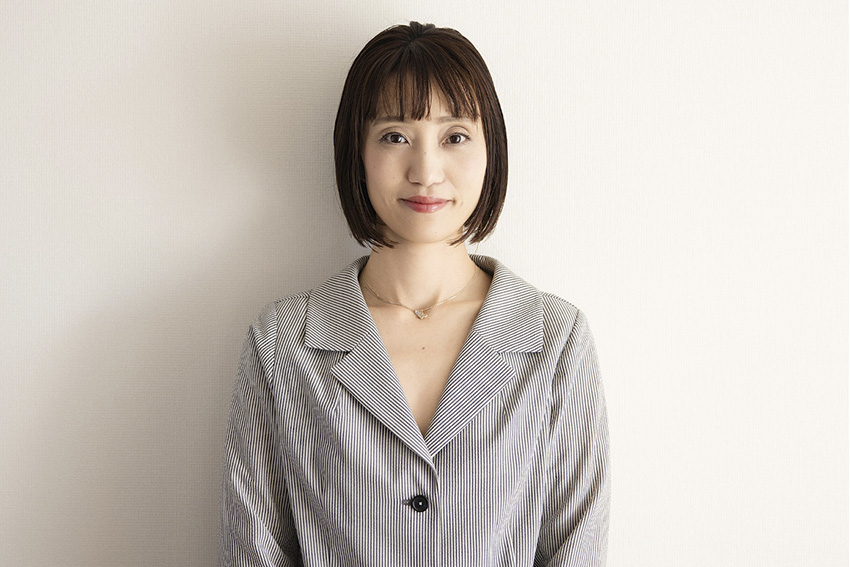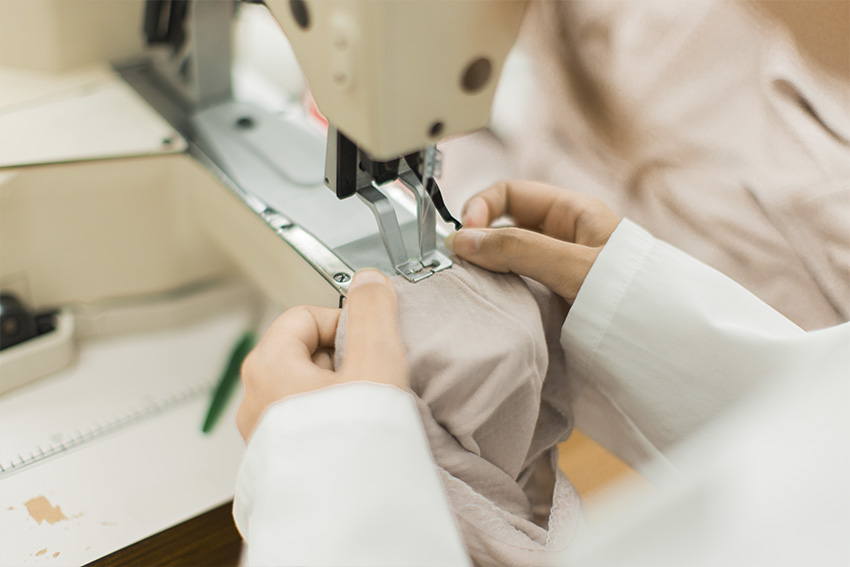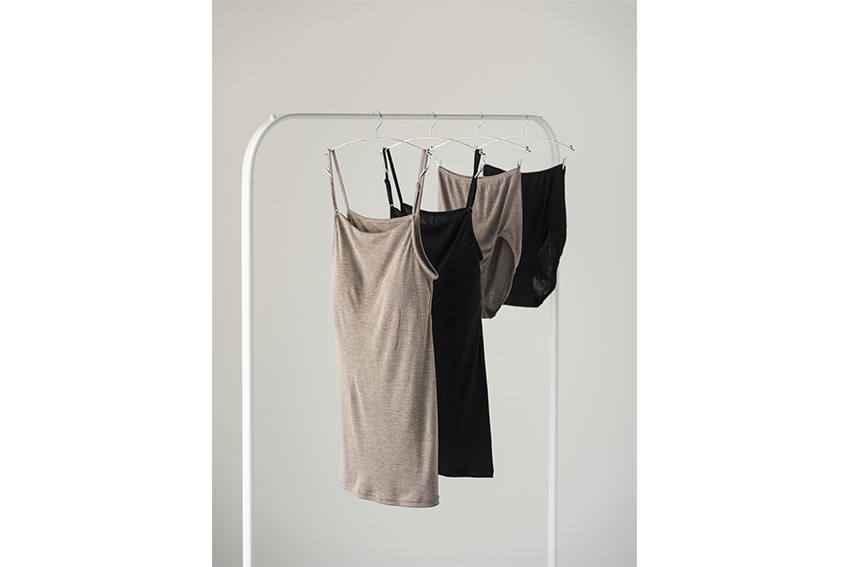Takagi provides women with genuine sanitary products that support their clients with comfort and peace of mind.

Japan has a historically deep clothing culture with examples such as kimonos and yukatas. This clothing is characterized by timeless lines that have gone through numerous eras and have improved over time. Today, Japan is famous for its cultural heritage, craftsmanship, quality, and innovative designs and technology integrated into supply chains. How would you define the uniqueness of Japan’s fashion and apparel industry?
Hearing you asking this question really makes me realize that the answer is hard to convey. I find myself wondering how exactly to answer you, particularly when this question relates to the entire fashion industry in Japan. As you mentioned, Japan does possess accumulated technologies, with many companies working diligently to research fashion and materials. I think this pursuit of knowledge comes from the desire of Japanese people to meet the needs of the time. As the country and the people have evolved, so too have the lifestyles and tastes of the people. Our company has always considered how to accommodate ourselves in the evolving nature of our country. This is where the pursuit of enriching people’s lives comes from, and therefore, constant improvements and developments are needed. Takagi has worked hard to develop materials that can meet the specifications of each era. This sort of cyclical nature of the fashion industry here in Japan points to the unique aspects you asked about.
When I think about our company and look back to the 1960s, we used to use cotton produced locally here in Nara to make our underwear. Around this time, sanitary napkins were launched in Japan, and I remember that my grandmother thought that we would need panties that go well with those sanitary napkins. She also thought that underwear needed to be something that allows women to move easily, particularly working women. Around this era, underwear was 100% cotton, but my grandmother decided to develop a new type of material for underwear that was more flexible. Nowadays, flexible material is everywhere, but at that time, it was something that wasn’t common at all. It’s a material made of cotton mixed with spandex, which is suitable for sanitary panties because it prevents napkins from shifting.
This is why she pushed ahead with the development of fabrics and sanitary panties, making our company a pioneer in this category. I feel that my grandmother was very good at looking ahead and identifying market trends of the future. I think her decisions aligned with the Japanese fashion industry’s uniqueness. Our company has evolved to align with the fashion industry of Japan, constantly updating our products.
Evolving over time clearly is a theme for your company. Currently, Japan has a population of over 125 million, but over the next 15 years, Japan anticipates significant demographic shifts that will be characterized by both an aging and declining population. In 2023, the birth rate reached a low point of 1.2, which will inevitably substantially impact Japanese businesses and industries across the board. Can you talk about some of the challenges or opportunities this creates for your company and what you’re doing internationally to help address the shrinking domestic market?
We have a factory in Nagasaki, and this area is facing significant challenges in terms of population decline. Nara is also facing these challenges but benefits from being close to the major city of Osaka, therefore, the problems in Nagasaki are much more serious. In Nagasaki, it is very difficult to secure labor because so many people are flowing out of rural areas like Nagasaki to metropolitan areas like Osaka and Tokyo. Since we place such an emphasis on craftsmanship, it is hard to strike a balance; therefore, to address this issue, we have set up our production line in Nara, which started in June 2024. There are only five people in this production line, but together with the Nagasaki factory, which can produce volume, we are trying to leverage our production capacity.
Our company also has a factory in Vietnam, and we need to find solutions to this population crisis. We found there that a lot of respect is still placed on made-in-Japan products. This is why we emphasize our made-in-Japan quality when attending international exhibitions. In Vietnam, we are trying to import technologies from Japan in order to maintain quality. I think it is very important for our company to keep communicating that our technology is made in Japan, something that we need to communicate in our branding as well. Going forward, rather than just dispatching people from Japan to Vietnam, we would also like to bring Vietnamese workers to Nara or Nagasaki for training so that they can learn more about our made-in-Japan technology.
In regards to looking overseas to ensure long-term success, we understand that the domestic market is shrinking, and we are looking at potential overseas markets. Asia is a region with growing populations, so we are looking at that region to distribute our products. This has been our main activity for the past two to three years. We have now been distributing our products in Taiwan and Vietnam, and while there have been some problems, the overall reaction has been very good, giving us some strong and positive momentum.
Recently we found a very good client in the US, and we have started launching our products there. Sweden is another country where we have a good partner company, we are trying the possibility of OEM production using specific materials. The countries I’ve mentioned are our focuses right now, providing our company with solutions for long-term success.
Apart from Vietnam and Taiwan, which countries are you looking to focus on?
We did challenge the Singaporean market a few years ago but we weren’t very successful. Singapore is the center of business in Asia and we’ve always looked at ways to penetrate that market. A particular customer was promoting made-in-Japan products in Singapore through e-commerce channels and they approached us, so we have now decided to use that channel to promote our products. It was through utilizing live commerce with influencers that the recognition for our products really set off.

You mentioned a few different partnerships today, and from our research, we saw that you are actively looking for distributors for your private brands globally. What kind of partnerships are you looking for, and what specific markets are you looking for?
Our main partner company’s target is slightly different in terms of the category. The basic image is a commitment to materials, comfort, and craftsmanship. Regarding who we would like to work with, we are looking for companies that match our philosophy yet have a different customer base so that the partner and our company can complement each other. This will raise the brand awareness of the two companies and expand the types of products we can offer, benefiting from each other’s technology.
Takagi’s sales channels focus on OEM partnerships as well as distribution to retailers. In the 2000s, you launched your own e-commerce brand, bodyhints, to better meet the needs of women. Can you tell us the synergies you are able to generate between these different business segments? Which do you prioritize more today, your OEM business or your private brand business?
In Japan, there is a saying that you “Cannot have one’s fingers in two pies” However, focusing mainly on one business is risky. We would like to diversify our business by spreading out the risks and balancing various businesses.
We are now in the 94th year of our company, and in order for us to continue doing business, we cannot narrow our focus to just one thing. We would like to be good at both our OEM business and our private brands, and through these businesses, we have been able to enhance our technology. Through our factories, we have created various ideas and accumulated more technologies.
This mentality applies to our factories as well, since we have them both domestically and overseas. We would like to keep these two production bases, with our overseas operations in USD and domestically operating in JPY. Our business is quite sensitive to exchange rate fluctuations, meaning that with two production bases, we can compensate for any downswings in one of the currencies. Keeping these two channels is key to the future sustainability of the company as a whole.
Our company philosophy is to pursue true comfortability through our manufacturing processes. This also applies to our employees and their comfort as well as customers who wear our products. By providing comfort through many channels, we can achieve our company philosophy.

Traditional menstrual products present a few challenges. One example is the environmental waste, and the other is the lack of breathability. econap® products. Can you tell us how you are able to overcome these challenges with the econap®, and what the added benefits for customers are in terms of sustainability?
Earlier, I mentioned my grandmother’s philosophy when founding the company. I also talked about shorts to support paper napkins. We all felt she had a knack for foreseeing the needs of the future. At that time, paper napkins were used for sanitary purposes, and a lot of paper was wasted. The company felt that this kind of waste was not sustainable in the long term.
Women all have different skin types, which means that each woman has different sensitivities as well. Our company needed a better solution for sanitary products, so we began to think about ways of applying our technology. This is where the idea of econap® came from. When it comes to sanitary products, you have to ensure that they can absorb liquid. The application of the technology has enabled us to patent econap® thanks for its high absorption efficiency, permeability, antibacterial and deodorizing effects.
How do your designers and pattern makers effectively accommodate diverse body types and styles across various designs?
The outer design doesn’t stretch, so we are able to use the same patterns, which remain the same over time. The inner layer, however, must stretch so we have to accommodate for that. Patterns also need to cater to the different ages of our customers. We do have a master pattern for our inner layer, and once we make the decision on the material to use, we then make adjustments to the pattern. For each age range, we then apply different materials, and once a pattern is ready, we have our female employees try on the samples. They all have different body shapes and a sense of comfort, so we are able to collect a wide range of feedback internally in the company. We will take that feedback, make adjustments, and sample them again and again until we finally reach something we are all happy with. It isn’t just about making one pattern. It is more about making lots of small adjustments until everyone is happy with the product we have produced.
Recently, CAD software for apparel has been released, and with this, we can place the measurements for the size M, and the software will give us the required measurements for other sizes, such as S or even XL. This is automatic and based on the rules of the system. Although this automatic system is a good start, we still need to make lots of smaller manual adjustments.
Our company strengths lie in our capabilities with different materials. Material development capabilities are on top of our excellent design and sewing skills. We have always upgraded the materials to match the needs of different eras. I think this material development aspect of our company allows us to differentiate ourselves in this market.
Imagine that we come back in 2030 and have this interview all over again. What goals or dreams do you hope to achieve by the time we come back for that new interview?
Our company has grown based on our OEM business, and although we have private brands, these are still relatively small and niche. By the time you come back for that new interview, I hope that our company has increased our private brand awareness. I want to see more people talking about our brand and telling their friends about our excellent products. This isn’t just limited to Japan either, as I want to spread our beloved brands all across the world. Comfortability is the core and common goal of our company, and I hope that once the public tries our products, they will understand our mission. By having people understand that all of these products are made by Takagi, we can also increase the brand awareness of our main company itself.
On top of these business-related goals, our company has been making various social contributions by visiting local elementary schools and supporting those schools by educating the students about sanitary products. While this activity is currently local, we want to expand it nationwide.
For more information, please visit their website at: https://takagi-innerwear.jp/takagi_en/takagi_en.html
0 COMMENTS